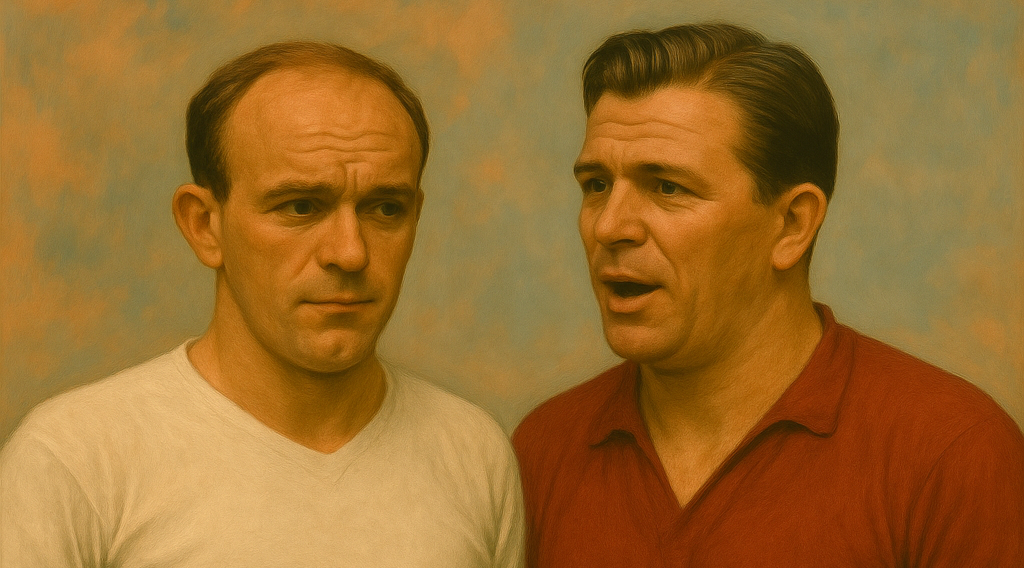
The GOAT Among Real Madrid Legends?
The pantheon of football is engraved with countless great names, but partnerships that redefine not just a club’s identity but the sport itself are exceedingly rare. In the 1950s, the white empire of Real Madrid stood tall, and at its heart were two of the greatest forwards in football history: Alfredo Di Stéfano and Ferenc Puskás.
Di Stéfano, known as ‘La Saeta Rubia’ (The Blonde Arrow), was the prototype of the ‘total footballer’ who dominated the entire pitch. Puskás, nicknamed ‘The Galloping Major,’ was a goal hunter with the most lethal left foot in football history. When these two giants met after turning 30, many doubted they could coexist, but the result was the birth of the most dominant attacking duo in the history of the sport.
Comparing these two legends from a 2025 perspective is more than just determining who was the better player; it is an exploration of two different interpretations of the very essence of ‘greatness.’
1. Playing Style: The Complete Commander vs. The Lethal Finisher
Alfredo Di Stéfano: The ‘Total Footballer’ Who Dominated Everything on the Pitch
Di Stéfano was a player ahead of his time. He wasn’t just a forward who stayed up front; he was a ‘total footballer’ who influenced every corner of the pitch.
Eusébio: “He is the most complete footballer in the history of the game.”
His greatest attribute was his ability to roam the entire field, backed by tireless stamina and exceptional football intelligence. He would be finishing an attack one moment, then dropping deep into the midfield to help with defense and initiate the build-up the next. He was a manager on the pitch, designing the team’s victory.
Ferenc Puskás: The Greatest Left Foot in Football History
Puskás was synonymous with the word ‘goal.’ His style of play was concise and deadly. He created goals not with dazzling dribbles, but with perfect ball control and shots of unpredictable timing.
His left-footed shot, in particular, possessed immense destructive power, often scoring cannonball-like goals from over 25 meters out that seemed to rip the net. He was a natural-born goalscorer who could change the course of a game with a single shot.
2. Career Comparison: Greatness Proven by Records
Overall Club Career Statistics
| Player | Clubs | Appearances | Goals | Goals per Game |
|---|---|---|---|---|
| Alfredo Di Stéfano | River Plate, Huracán, Millonarios, Real Madrid, Espanyol | 669 | 487 | 0.73 |
| Ferenc Puskás | Budapest Honvéd, Real Madrid | 530 | 514 | 0.97 |
Real Madrid Career Record
| Player | Seasons (1953-1966) | Appearances | Goals | Goals per Game |
|---|---|---|---|---|
| Alfredo Di Stéfano | 11 (1953-1964) | 396 | 308 | 0.78 |
| Ferenc Puskás | 8 (1958-1966) | 262 | 242 | 0.92 |
Major Honors and Individual Awards
| Category | Alfredo Di Stéfano | Ferenc Puskás |
|---|---|---|
| European Cup | 5 times | 3 times |
| La Liga | 8 times | 5 times |
| Ballon d’Or | 2 (1957, 1959) | 2nd (1960) |
| Super Ballon d’Or | 1 (1989) | – |
| Pichichi Trophy (La Liga Top Scorer) | 5 times | 4 times |
3. The Crossroads of Destiny: The Night Football History Changed in 1960
The moment the partnership between these two legends shone brightest was the 1960 European Cup final. This match is regarded as the greatest in history, a perfect harmony of football’s beauty and destructive power.
The Legendary 7-3 Victory
Real Madrid achieved a phenomenal 7-3 victory over Germany’s Eintracht Frankfurt, securing their fifth consecutive European Cup. In this match, Di Stéfano scored a hat-trick (3 goals), and Puskás scored an incredible four goals (a haul).
Proof of a Perfect Partnership
This game perfectly demonstrated how the duo’s partnership worked. Di Stéfano roamed the entire pitch, controlling the tempo of the attack and creating opportunities. Puskás finished the chances created in the space Di Stéfano made with his lethal decisiveness. In essence, Puskás was the soloist in the orchestra conducted by Di Stéfano.
4. Contrasting Fates on the International Stage
Ferenc Puskás: The Tragic Hero of the ‘Mighty Magyars’
Puskás was the captain of the Hungarian national team, the ‘Mighty Magyars,’ who reigned as the world’s best in the 1950s. He left an unbelievable record of 84 goals in 85 international matches. However, despite playing through an injury in the 1954 World Cup final, he had to watch West Germany’s comeback victory in what became known as the ‘Miracle of Bern.’
Alfredo Di Stéfano: The Unlucky Genius Who Never Played in a World Cup
Di Stéfano wore the jerseys of three different countries—Argentina, Colombia, and Spain—but never once stepped onto the pitch at a World Cup finals. The fact that the greatest player who dominated his era had no connection to the World Cup remains the sole regret of his career.
5. Legacy: The Architect of a Dynasty vs. The Immortal Goalscorer
Di Stéfano: Forging the Identity of Real Madrid
Alfredo Di Stéfano is Real Madrid itself. He was more than just a goalscorer; he was the man who instilled the club’s winning DNA. His leadership and influence made Real Madrid the ‘Club of the Century,’ and the ‘Super Ballon d’Or,’ awarded to only one player in history, attests to his unique status.
Puskás: Leaving His Name on the Most Beautiful Goal
Ferenc Puskás’s name has become synonymous with the ‘most beautiful goal.’ Since 2009, FIFA has honored his legacy by awarding the ‘FIFA Puskás Award’ to the player who scored the most spectacular goal of the year. This symbolically shows how his career was filled with brilliant and wondrous goals.
Conclusion: A Greatness Completed Together
Alfredo Di Stéfano and Ferenc Puskás will be remembered as the greatest attacking duo in football history. The question of ‘who was greater’ is perhaps meaningless, because their greatness was completed through each other’s existence.
Di Stéfano was the architect and conductor of a dynasty. Puskás was the spear that pierced the enemy’s heart most powerfully and reliably on that path. Without Di Stéfano, Puskás’s left foot would not have had so many opportunities, and without Puskás, Di Stéfano’s grand designs would have lacked the final, decisive touch on countless occasions.
They reached the pinnacle of football in different ways, but in the end, they were two hearts that beat in perfect harmony for a single goal: victory.




